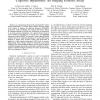Free Online Productivity Tools
i2Speak
i2Symbol
i2OCR
iTex2Img
iWeb2Print
iWeb2Shot
i2Type
iPdf2Split
iPdf2Merge
i2Bopomofo
i2Arabic
i2Style
i2Image
i2PDF
iLatex2Rtf
Sci2ools
97
Voted
BIBE
2007
IEEE
2007
IEEE
Morphometric Analysis of Hippocampal Shape in Mild Cognitive Impairment: An Imaging Genetics Study
—A computational framework is presented for surface based morphometry to localize shape changes between groups of 3D objects. It employs the spherical harmonic (SPHARM) method for surface modeling and random field theory (RFT) for statistical inference. Several new components are introduced to overcome previous limitations: (1) a general linear model is used to facilitate controlling for covariates; (2) a new SPHARM registration method SHREC is proposed to better align SPHARM models; and (3) an estimated smoothness is used in RFT-based analysis to obtain more accurate results. This framework is applied in a mild cognitive impairment (MCI) study to examine hippocampal shape changes related to diagnostic and genetic conditions. Several interesting findings from our analyses suggest combining imaging phenotypes and genetic profiles has the potential to elucidate biological pathways for better understanding MCI and Alzheimer’s disease.
BIBE 2007 | Bioinformatics | Hippocampal Shape Changes | Shape Changes | —A Computational Framework |
| Added | 02 Jun 2010 |
| Updated | 02 Jun 2010 |
| Type | Conference |
| Year | 2007 |
| Where | BIBE |
| Authors | Li Shen, Andrew J. Saykin, Moo K. Chung, Heng Huang |
Comments (0)

